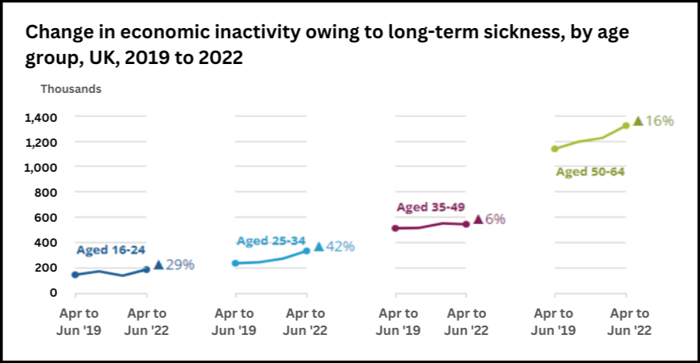
Investigations are continuing as to what are the major factors influencing this increase, but the ONS suggests that it could be the impact of NHS waiting times, long COVID, and the ageing workforce.
Matthew Taylor, known in the past for the report to government titled Good Work: The Taylor Review of Good Working Practices and now the Chief Executive of the NHS Confederation, said, “We do need a greater awareness of the way in which gaps in health and care provision are contributing to the problem with people of working age not working… I would very much encourage employers to recognise that waiting for health interventions may be a challenge for their workers and to support them in that”
While older people still make up the majority, younger people have also seen some large proportional increases whilst wholesale and retail industries seem to be bearing the brunt of the problem.

This long-term sickness is obviously a significant issue for the individual people and families involved, but the knock-on affect to business and services is a major concern as well. Workforce costs can be a major proportion of an organisation's expenditure, therefore understanding the reasons behind absence and having systems in place to allow you to deal with them in an effective and timely manner is essential
After the last few years, few would now deny the need for stringent absence monitoring, but for some it remains an uncomfortable topic due to its emotional and political implications, especially after going through the pandemic and necessary self-isolating.
With this recent evidence, this issue is only likely to become more important for the shrinking workforce, but you need to be extremely careful how absences are covered as this can also create a dangerous reversal of motivations. If the policy is to ask colleagues to cover for absent workers by putting in overtime, this can inadvertently almost incentivise absenteeism if it translates to a bigger pay package for other team members. This may lead to unsustainable workloads for the most eager or highly skilled, and where this happens, organisations may need to revise their procedures for covering absences, for instance by spreading workload across teams or by shifting team members. They may also need to strive for a more honest approach with mechanisms that engender a peer pressure mentality to reduce absenteeism. This can only be achieved by creating a culture that better fits its workforce attendance requirement to the real demands for presence. This underlines the need for a full understanding of precisely who should be present at work at any time, what flexibilities and seasonality's exist, and if there are any skills or training gaps. Only then will it be able to accept and effectively manage genuine long and shorter-term absence and challenge ‘duvet days'.